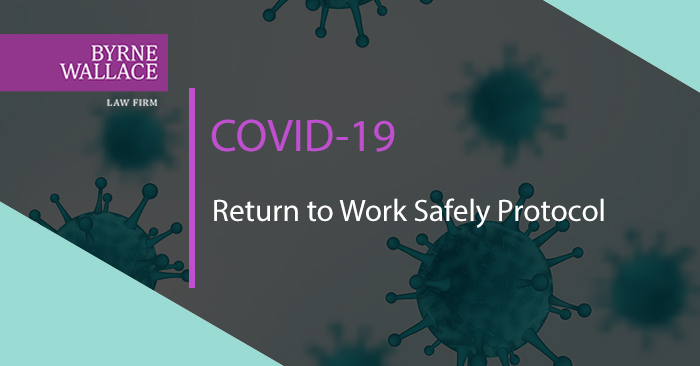Return to Work Safely Protocol published but key questions remain unanswered
Monday, 11 May 2020
A Return to Work Safely Protocol (“the Protocol”) was published on Saturday, 9 May 2020, by the Health and Safety Authority, the Health Service Executive (“HSE”) and the Department of Business Enterprise and Innovation. The Protocol provides practical guidance in advance of the first phase of the easing of Government restrictions on Monday, 18 May 2020. The Protocol leaves unanswered many employers’ questions about the legal risks and requirements associated with re-opening their businesses.
The Protocol contains a combination of mandatory measures and recommendations for employers and workers.
Mandatory measures that employers must take when reopening
- Maintain physical distancing across all work activities.
- Implement thorough and frequent cleaning of frequently-touched surfaces in the workplace.
- Implement a “no hand shaking” policy.
- Appoint at least one “lead worker representative” charged with ensuring that COVID-19 measures are strictly adhered to in their place of work.
- Develop a COVID-19 business response plan.
- Provide COVID-19 induction training to all workers.
- Consider workers’ individual risk factors (e.g. older workers, underlying medical conditions).
- Establish a response plan to deal with any suspected case of COVID-19.
- Establish contingency measures to address increased absenteeism and implement measures necessary to reduce the spread of COVID-19.
- Identify a designated isolation area for dealing with COVID-19 cases on site.
- Ensure that appropriate hygiene facilities are in place to accommodate workers adhering to hand hygiene measures.
“Return to work” form
Employers must establish and issue a pre-return to work form for workers to complete at least three days in advance of the return to work. The form should seek confirmation that the worker, to the best of their knowledge, has no symptoms of COVID-19 and also confirm that the worker is not self-isolating or awaiting the results of a COVID-19 test. Employers must also keep a log of contact or group work to facilitate contact tracing and display information on the signs and symptoms of COVID-19.
Workers’ obligations
Workers must make themselves aware of the symptoms of COVID-19 and self-isolate and contact their GP if they experience symptoms. They must report to managers immediately if they become unwell during their shift. They must ensure they are familiar with and follow hand hygiene guidance and advice and avoid touching their eyes, mouth or nose. Workers must not share bottles or cups and use their own pens for work matters such as signing in.
Recommended measures that employers might decide to take
- Review sick leave policies.
- Ensure any occupational health service, if provided, is available to address any worker concerns and communicate the messages about good hand hygiene, respiratory etiquette and physical distancing.
- Make available the necessary public health advice from the HSE and other sources as appropriate to their workers if there is no occupational health service available in a workplace.
- Agree with workers or trade unions any temporary restructuring of work patterns required to implement the COVID-19 prevention measures in the workplace.
Personal Protective Equipment (“PPE”)
The Protocol makes several references to PPE, and states that an employer must provide insofar as is “reasonably practicable” PPE including gloves and masks and clinical waste bags. While those operating within the healthcare sector (and some other specialist sectors) will likely have particular needs for PPE, the question of whether facemasks should be relied upon by the general population as a measure to prevent the spread of COVID-19 remains a matter of debate.
The World Health Organisation maintains that the use of medical masks in the community may create a false sense of security, with neglect of other essential measures such as hand hygiene practices and physical distancing, and may lead to touching the face under the masks and under the eyes, result in unnecessary costs, and take masks away from those in health care who need them most, especially when masks are in short supply. Further health and safety considerations may arise in workplaces where it has not been the practice to use facemasks in the past, including their correct use and the safe disposal of masks by workers, as well as the source and quality of the masks used. Employers may wish to consider carefully what PPE may be appropriate or necessary for them to provide for workers pursuant to these new provisions.
“At risk groups”
The Protocol requires employers to "take into account workers' individual risk factors" including older workers and those with underlying health conditions. It states that, if an at-risk or vulnerable worker cannot work from home, employers must make sure that they are preferentially supported to maintain a physical distance of two metres. However, little further guidance is provided by the Protocol as to how employers obtain the necessary information to establish whether an employee is at any additional risk and what further measures may be needed if one or more of their workers is considered "at risk".
The HSE has provided information on two categories of people; those "at very high risk" and those at "high risk". The advice is different for the two groups. Employers must now consider how best to ask if any of their workers fall within either of the two categories. Many of the relevant risk factors may also place the workers into one or more of the nine grounds protected by the Employment Equality Acts, including the disability ground and the age ground. Understandably, employers are mindful of their health and safety obligations but are also wary of being accused of discriminating against a worker or group of workers in their attempt to navigate the new workplace rules.
The Protocol does not provide guidance to employers about whether employees who are – or might be – in at risk groups should be recalled to work as businesses re-open.
Data protection considerations
The focus of the Protocol is, understandably, on public health and practical measures to ensure the safety of employers, workers and their customers and clients as people return to work. However, the COVID-19 response gives rise to significant questions about how employers are to comply with data protection requirements while also protecting the health and safety of staff and customers.
The Data Protection Commissioner has acknowledged the particular circumstances caused by the COVID-19 pandemic, and there are certain public health considerations which facilitate the collection of this data, but many legal obligations remain in place. Employers should ensure that “pre-return to work” forms do not gather more information than is required for the purpose of adhering to the Protocol. Organisations are also reminded to ensure that any records created and retained for the purpose of the Protocol meet the required privacy and security standards.
A living document that is likely to be developed further
The newly published Protocol presents some useful guidance for employers and workers reopening their organisations but many key questions remain unanswered. The Protocol is likely to be developed further in light of our developing experience of managing the COVID-19 crisis.
For further information please contact Loughlin Deegan or Rhona Murphy from the ByrneWallace Employment Law team or your usual ByrneWallace contact.
Please note that the content of this summary does not amount to professional advice. Legal and tax advice should be sought in respect of specific queries. The COVID-19 situation is evolving rapidly and this update is provided on the basis of information available as at 11 May 2020.

